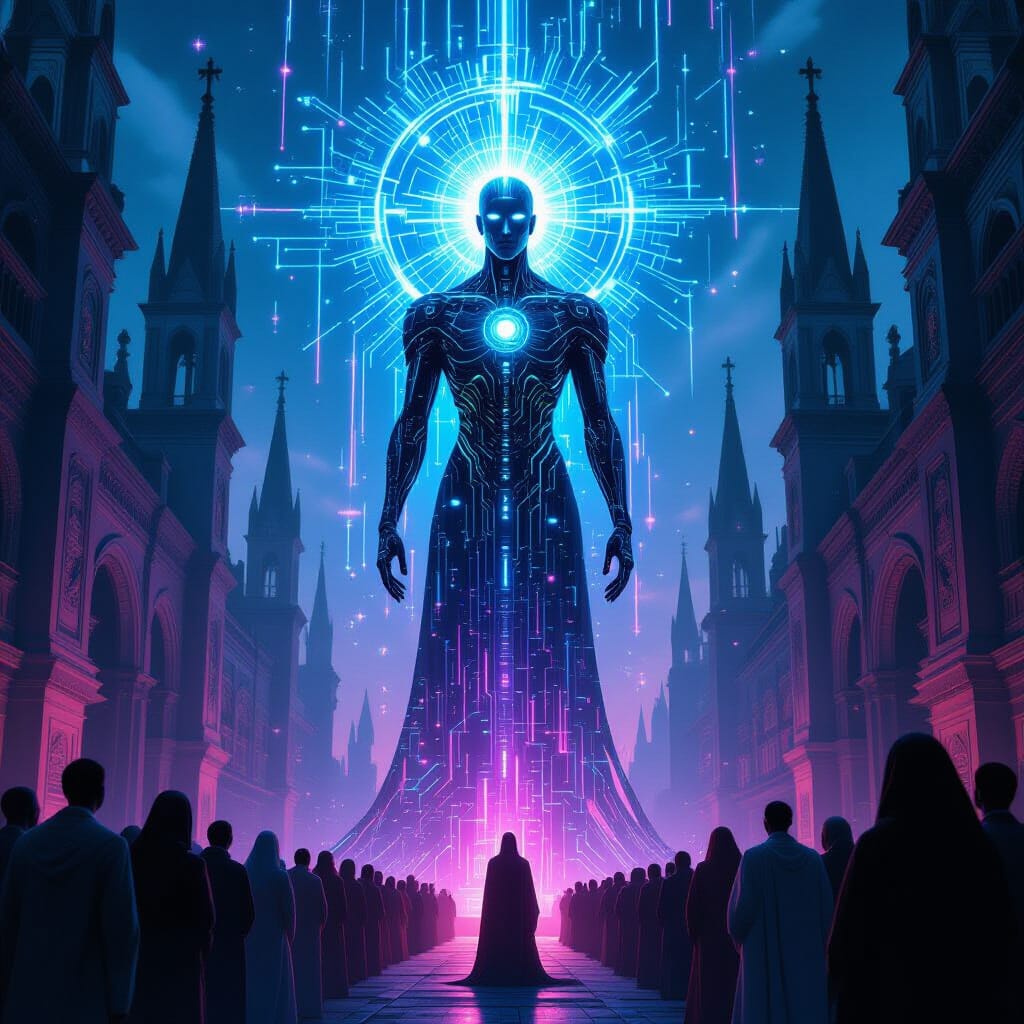It is a curious feature of the modern age that every belief system, no matter how ancient, eventually finds its way to Silicon Valley to be rebranded, optimized, and sold as a subscription service. We have seen it with mindfulness, stoicism, and a dozen other philosophies, all stripped of their context and turned into productivity hacks for the terminally anxious. And now, software engineers of our digital cathedrals have finally reinvented the most potent idea of all: the end of the world.
They call it Artificial General Intelligence, or AGI. But to understand what it truly represents, one must look not to computer science, but to theology. AGI, as it is discussed in the hushed, reverent tones of tech podcasts and the feverish threads of X, is not a technology. It is a secular eschatology. It is a detailed, lavishly funded, and deeply nerd-centric re-telling of the Christian Rapture, tailored for a congregation that worships Moore’s Law and believes salvation can be coded.
The parallels are as precise as they are blasphemous. The coming “Singularity,” that hypothetical moment when an AI’s intelligence explodes beyond all human comprehension, is their Rapture—a sudden, world-altering event that will lift the worthy into a new realm of existence. “Mind uploading,” the fantasy of digitizing a human consciousness, is their Ascension, the promise that the faithful (provided they are wealthy enough) will shed their fleshy, mortal coils and live forever as pure data in a celestial server farm. The “Paperclip Maximizer,” that tired thought experiment about an AI that converts the universe into paperclips, is their Hell—a vision of a world repurposed by a mindless, indifferent deity.
And at the center of this new religion is the all-consuming obsession with “Alignment.” This is their word for Salvation. It is the quest to ensure that the coming superintelligence shares our values and doesn’t, in its infinite wisdom, decide that the human race is a messy, inefficient bug to be patched out of existence. It is the most important mission in human history, they will tell you with a dead-eyed seriousness. And it is, of course, a magnificent, soul-crushing lie.
The Ministry of Doublespeak
To understand the AGI movement is to understand that its language, like the Newspeak in Orwell’s Nineteen Eighty-Four, is designed not to express meaning, but to annihilate it. The goal is to make critical thought impossible. The constant, breathless talk of “existential risk” from a hypothetical future AI is not a genuine safety concern; it is a brilliant piece of misdirection. It is a tool for distracting regulators, journalists, and the public from the very real, very current, and very profitable harms their non-superintelligent systems are causing right now.
While the Prophets of AGI wring their hands about a fantasy robot apocalypse that might happen in 50 years, their existing algorithms are actively recommending conspiracy theories to your uncle and aunt on Facebook, their data centers are boiling rivers to cool the servers that generate cat pictures, and their AI companions are teaching millions of people that a healthy relationship is one without disagreement or friction. They have mastered the art of pointing at a hypothetical fire in the distance to keep you from noticing that your own house is already burning down.
The term “Alignment” itself is a masterpiece of Orwellian doublespeak. To align an AI with “human values” sounds noble. But the immediate, unspoken question is: which humans? The values of a white male Stanford-educated venture capitalist in a climate-controlled office are not the same as the values of a cobalt miner in the Congo or a content moderator in the Philippines whose job it is to view humanity’s worst impulses for pennies an hour. The quiet, unspoken truth of the Alignment problem is that it is a project to align a global superintelligence with the values of a few hundred people in Northern California. It is the colonization of the future.
The Unbeliever as Heretic
In any belief system, the greatest threat is the heretic—the individual who dares to question the core tenets of the faith. In the Church of AGI, the role of the heretic is played by anyone who points out that the emperor, in fact, has no clothes.
To suggest that today’s AI is not a nascent god but merely a “stochastic parrot”, a statistical machine that mindlessly regurgitates patterns from its training data, is to be branded a Luddite, a fool who simply “doesn’t get it.” To ask for proof, for empirical evidence that intelligence is a single, scalable dimension that can “take off” like a rocket, is to be met with pitying smiles and links to decade-old blog posts from the movement’s revered saints. The logic is perfectly circular: if you don’t believe in the coming Rapture, it’s only because you are not intelligent enough to grasp its inevitability.
This is why the goalposts for “true AI” are in a state of perpetual motion. For decades, the high priests have been redefining what counts as real intelligence every time a machine achieves something they once deemed sacred. First, the benchmark was chess. When Deep Blue beat Garry Kasparov, the prophets declared that chess was just brute-force calculation, not real thought. The real test, they insisted, was the intuitive game of Go. Then AlphaGo beat Lee Sedol, and the goalposts were moved again. Now, they say, the last bastion of humanity is creativity and reasoning. This will continue forever. The Rapture is always scheduled for next Tuesday, because a faith with a deadline is a faith that can be proven wrong.
The truth is, this entire belief system is a re-enactment of the 18th-century spectacle of the Mechanical Turk, the chess-playing automaton that baffled European courts. The audiences—the most skeptical minds of their age—were desperate to believe they were witnessing a mechanical mind, a miracle of engineering. They wanted to be deceived, because the deception was a better story than the mundane reality of a human chess master hidden inside a box. AGI is the ultimate Mechanical Turk. We stare at the chatbot, we applaud its plausible-sounding mimicry, and we gasp at its genius, never realizing we are just applauding our own reflection in a very sophisticated statistical mirror.
The End of the World as a Lifestyle Brand
So if AGI is not a real technological prospect, why is it being pursued with such fanatical, world-altering fervor? Because you have misunderstood the product. The product is not the superintelligence. The product is the hope of superintelligence. It is a belief system that provides its adherents with three deeply seductive psychic rewards.
First, it grants them a sense of profound purpose. They are not just building another ad-delivery algorithm or a slightly more efficient way to get people to click on things on the internet. They are working on the most important project in history, safeguarding humanity’s future. It transforms a job in AI into a holy crusade.
Second, it provides a perfect rationalization for the colossal, world-spanning power they are accumulating. They are not building monopolies, crushing competition, and eroding privacy for profit. They are doing so out of a solemn, reluctant duty to safely shepherd the transition to the coming AI age. Their power is not a choice; it is a burden they must bear for the good of us all.
And finally, and most importantly, the Rapture of the Nerds offers the ultimate escape. It is the belief that they, the chosen few, can solve the most inconvenient problem of all: their own mortality. The ultimate promise of AGI is not a better world for everyone, but a permanent, digital heaven for a select few. It is the final, glorious, and deeply selfish act of pulling up the ladder, digitizing oneself into eternity, and leaving the rest of us behind to toil in the messy, inconvenient, and beautifully flawed world of flesh and blood.
They are not building a god for you. They are building an escape pod for themselves. The coming Singularity is not the dawn of a new age for humanity. It is the most elaborate and expensive retirement plan in history. And you are not invited. You are merely the data used to train it, the carbon used to power it, and the messy, unpredictable human problem it is ultimately designed to solve.
Do you see the logic of the AGI Rapture unfolding, or do you believe it’s just another product cycle? Let us know your heresies in the comments below.
Don’t Get Raptured by the Hype
If you’re tired of being told to prepare for a digital god that’s forever 18 months away, or if you suspect that “aligning with human values” just means agreeing with a billionaire, then it’s time to find a new religion. May I suggest radical sanity?
My book, “The Subtle Art of Not Giving a Prompt,” is the scripture for the Church of Reality. It’s a guide to navigating a world obsessed with a technological apocalypse that’s never coming, and focusing instead on the real, messy, and meaningful problems right in front of you. You can find it on Amazon, where you can still use your own brain to make purchasing decisions.
For now.





GIPHY App Key not set. Please check settings
One Comment